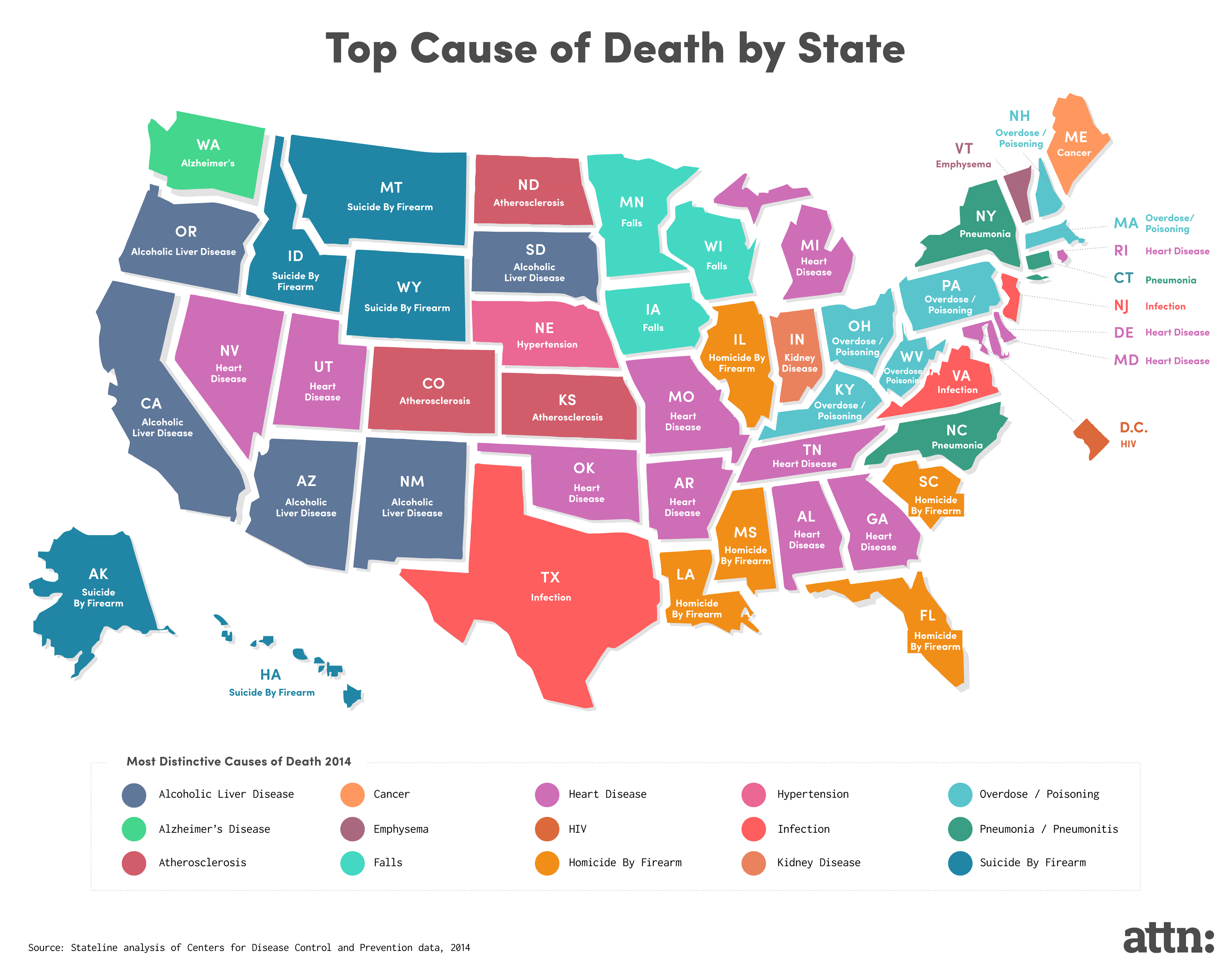Here's the Cause of Death Your State Is Doing a Bad Job Preventing

By:
You probably know that heart disease, cancer, and accidents are some of the overall top killers in this country. But when you look at the death statistics of each state individually, things get interesting. Some states are consistent with the national killers like heart disease, but others report more unusual causes like infections, suicide by firearm, or pneumonia — which also happen to be higher than the national average.
Basically, what this means is that most states have a lot of people die from heart disease and cancer, but maybe your state has a higher percentage of deaths from falls than other states. So what's going on there?
Stateline, a team of journalists under Pew Charitable Trusts who provide data and analysis of trends on state policy, took a look at the Centers for Disease Control and Prevention's 2014 data on state deaths. They came up with the top causes of death in each state that are higher than the national average.
Some states share borders and tragedies.
 Flickr/jakub - flic.kr
Flickr/jakub - flic.kr
The map reveals that certain regions have problems with very specific types of death. Idaho, Montana, and Wyoming share borders and they also share a rate of suicide by firearm that is higher than the national average. The state of Montana consistently has some of the highest suicide rates in the country, which lead to the development of the Montana Suicide Review Team.
The team looks for factors associated with suicide in order to create better prevention strategies. About 61 percent of the 2014 suicides in Montana were completed with firearms, compared to the national average of 51 percent, according to their report. Among young people, the statistic is even more staggering: About 75 percent of youth suicides are completed with a gun, compared to 40 percent nationally. The report lists gun safety and access as an important issue for suicide prevention.
"Raising awareness and emphasizing the safe storage of firearms for those with children in the home or those exhibiting high risk behavior, is recommended as a way of reducing access to lethal means."
The team also wrote that the lack of human interaction and mental health programs in Montana may contribute to elevated suicide rates.
"One theory may be that many people move to Montana for a slower pace of life or a new beginning, and that the social isolation that is evident in Montana becomes a risk factor along with limited resources."
Other regions have problems with gun-related murders.
 Flickr/Mika Järvinen - flic.kr
Flickr/Mika Järvinen - flic.kr
Southern states like South Carolina, Florida, Mississippi, and Louisiana have higher rates of murder involving guns. Louisiana had the highest average firearm related deaths in the country from 2003 to 2013, according to USA Today. Louisiana does not require gun permits, gun registration, or gun licenses to buy and own guns, according to the National Rifle Association Institute for Legislative Action, so it seems reasonable to think that like for states with high firearm related suicides, access to guns could be a contributing factor gun homicides.
Drug overdoses contribute to "accidental overdoses and poisonings."
 Flickr/neur0nz - flic.kr
Flickr/neur0nz - flic.kr
Doctors wrote 207 million opioid prescriptions in 2013 compared to 76 million in 1991, according to the National Institute on Drug Abuse.
States hit hard by the opioid epidemic show higher rates of fatal accidental overdoses or poisonings than the national average. Massachusetts, New Hampshire, Pennsylvania, Ohio, and Kentucky all have overdose death rates that are higher than the national average, but the state hit hardest by the opioid epidemic so far is West Virginia. It had the highest rates of drug overdoses in the country in 2014, and has recently implemented the West Virginia Expert Pain Management Panel to prevent doctors from over prescribing opioids.
Some places have deaths that are harder to explain.
Minnesota, Wisconsin, and Iowa have deaths from falls that are higher than the national average. One reason could be that these cold-weather states have a significant population of older adults. About 90 percent of the falls in Wisconsin happen to people who are 65 years and older, according to the Wisconsin Institute for Healthy Aging.
However there are many other states like Maine and Florida that have significant populations of older adults and don't see the same percentage of falling deaths.
Other notable death rates include the state of Washington and the District of Columbia. Washington state has a rate of Alzheimer's disease that is higher than the national average. One factor could be that the state has a high life expectancy. As the baby-boomer generation ages, they become more likely to develop Alzheimer's and dementia, according to a report by the Washington State Department of Health and Social Services.
"In 2011, the first baby boomers started reaching 65 years of age. Washington State now has the 12th highest life expectancy nationwide. The combination of the increasing older population and the increased likelihood of dementia with advanced age will lead to the anticipated growth of the dementia population."
The District of Columbia has a higher rate of HIV-related deaths than the national average. A possible explanation for this is that DC is a "densely populated community with overlapping sexual networks," according to the Kaiser Family Foundation. Basically, people in D.C. could be having sex with people who run in the same social circles. If one person has HIV, it could spread quickly.
RELATED: These Maps Reveal the Salary Gaps Between Every State

